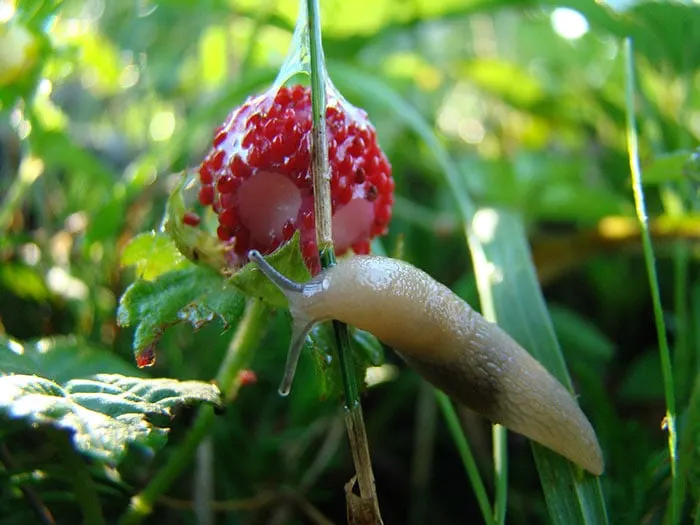This post may contain affiliate links, my full disclosure can be read here. As an Amazon Associate I earn from qualifying purchases.
Slugs eating your plants? Learn how to get rid of slugs in your garden safely with these organic methods.
Slugs are one of the most common garden pests that drive gardeners crazy.
Unlike most pests, you deal with slugs aren’t actually insects, they are mollusks that live on land.
While not as cute looking as snails both slugs and snails can be a real nuisance in the garden.
They are voracious eaters that can destroy your plants in just a few days if left untreated.

In a hurry? This will get rid of slugs quick and it’s organic!
Why Is Slug Control So Difficult In The Garden?
Controlling garden slugs can be difficult because they mainly feed at night. This means you often find the damage in the morning but don’t actually see the slugs on your plants.
This leaves you feeling frustrated wondering what is eating your plants.
You may try using a multi-purpose insecticide, natural or homemade but find it doesn’t help. This is because most insecticides just don’t work against slugs.
Then once you finally figure out that it’s slugs eating your plants you still have two problems to deal with.
One is the ick factor, most people find snails cute but slugs disgusting and don’t want to touch them.
The other challenge is if you want to collect them by hand when they are on your plants, you need to do it at night.
Do you really want to be in the garden when it’s dark with a flashlight trying to handpick slugs? Probably not, this is why making traps and deterrents are better slug control.
What Does Slug Damage Look Like?

Slugs prefer to eat young, tender seedlings and older leaves of established plants. This is because these type of plants are the most stressed.
You can recognize their feeding damage:
- If you find your newly planted seedlings look like nothing but stumps or leaf ribs in the morning, it was probably slugs mulching away overnight.
- On fruit like strawberries and tomatoes, slugs leave round holes.
- You find holes in the center of leaves with ragged edges, often they are longer on one side and narrowing towards the other side.
And of course, you can find evidence of slugs in the garden by looking for slime trails on the soil, plants, rocks, etc.
Why Slugs Attack Your Plants
One of the most frustrating things for me to deal with in our garden was slugs for a long time. Living in a valley our climate is damp and it’s the perfect conditions for slugs.
I couldn’t figure out why our gardens were damaged by slugs so badly each year and then something changed.
We started using the Back to Eden garden method. This is a form of no-dig and permaculture gardening that uses deep wood chip mulch.
Now wait a minute, one of the most popular tips to get rid of slugs and snails in your garden is to NOT use wood chip mulch.
So why did our slug problem go away after changing to a Back to Eden garden?
Well, it’s all about soil and plant health.
See the first year we put deep wood chips down in the garden, we started seeing less damage from slugs and insects.
Each year that went by the damage got less but here is the surprise, we had more slugs and snails in our gardens than ever before.
I’m not kidding you, when we go out into our gardens and we will see slugs and snails everywhere, except on the garden plants.
I struggled with understanding why this happened, I knew my plants were healthier then they had been before. So I figured that this was why.
Then I watched a video from Paul Gautschi and I finally understood.
See God created a balance in nature and insects and other garden pests are his “police force”. Their job is to remove sick plants so they can’t produce seed and create weaker plants.
Have you ever had two plants side by side in your garden, they look the same but one is being attacked by pests and the other isn’t?
We can’t always tell by just looking at them but one is healthy and the other plant is stressed.
When you first transplant seedlings into the garden, if it’s not done just right they get stressed. This gives off a signal for pests to come in and clear them out.
If plants are truly healthy they don’t give off singles like this and snails and bugs will normally leave them alone.
This also explains why the only damage by slugs we see on established garden plants is on the older leaves near the bottom that are starting to turn yellow and die anyway.
Slugs really are just trying to clean up the plants.
How To Get Rid Of Slugs

Slugs have a real job to do, but we still can’t let them destroy our gardens while we work to build up our soil and plant health.
So while you work on that here are some easy ways to get rid of slugs in the garden.
Beer Trap Bowls
One of the easiest ways to get rid of slugs is to trap them in beer.
To do this take a shallow bowl, a small disposable pie pan works great, and dig a hole in your garden.
Place the bowl inside so that the edge is level with the ground. Then fill it with about an inch of beer.
The slugs are attracted to the fermenting yeast smell and when they go in, they get trapped in the liquid and can’t get back out.
Remember to clean out the trap each morning and top it up with beer as needed.
As an alternative to using beer, I’ve had success making a mixture of water, yeast and a little sugar and filling the bowls with this mixture. It’s cheap and uses ingredients I already have in my kitchen.
Diatomaceous Earth
Bundle: 100% Food grade Diatomaceous Earth 50lb Bag W/Shaker Bottle
Diatomaceous earth is one of my favourite pest control methods in the garden. It has been the best solution for getting rid of cucumber beetles for me for years now and it’s pretty effective when it comes to slugs too.
Diatomaceous earth is made from fossilized seashells that have been turned into rock. It’s ground up into a powder and used for many things including insect control.
To help protect plants from slugs you can sprinkle diatomaceous earth around the base of the plants. It feels very sharp to insects, much like they are walking on glass shards and they avoid crossing it.
The one downside when using diatomaceous earth to get rid of slugs is that it loses its effectiveness when it gets wet. This means you need to apply again after a heavy rain.
It’s very important to use only food grade diatomaceous earth. Types sold for garden use often have additives to attract pests.
Board Traps
One simple method of trapping slugs is to place wooden boards or cardboard down in your garden paths. Slugs love to hide under these!
Simply place some 2×4’s in the garden and let them sit overnight.
Wait until the afternoon the next day to turn the boards over and collect and dispose of the slugs.
The reason for waiting until the afternoon is because slugs are active during the night and morning when it cooler, but like to shelter from the afternoon heat.
Grapefruit Peel Traps
One easy way to get rid of slugs is to make traps grapefruit. Slugs love grapefruit so it’s a perfect way to attract and trap them.
After eating your grapefruit place the peel halves into the garden upside down.
The slugs will crawl under to eat and hide. In the morning you can dispose of the slugs. If you keep chickens you can feed the slugs to them.
Copper Tape
Copper Foil Tape (2inch x 18ft)
Copper tape can be an effective way to keep slugs off your plants too. It’s said that slugs recipe an electrical shock when they try to crawl over the copper wire.
Is this true? I honestly don’t know but they really do seem to try to avoid going over copper as much as possible.
Try putting copper callers around the base of your plants to protect them from slug and snail damage.
If you have a larger garden and use raised beds an easier solution would be to place copper tape around the edge of the garden beds to keep slugs from coming into the beds.
Egg Shells
Eggshells can also help to deter slugs in your garden. Some people have had mixed results using eggshells.
I find they work best if they are coarsely ground and sprinkled thickly around the base of the plants.
If you grind them until they are a powder they aren’t sharp enough to bother slugs or snails.
On the other hand, if you leave them in large pieces slugs will have no problem crawling over them either.
Sand
Slugs don’t like to move over surfaces that are dry and scratchy. This is why it’s often suggested to place sand in your garden to help keep slugs away from the plants.
This can have some effectiveness but once the sand becomes wet slugs won’t have a problem crawling over it.
Wool
Wool can be an effective method of slug control too. They really don’t like to crawl over the coarse texture.
Try putting down wool roving in the garden, or buy wool slug pellets that expand and form a thick wool mat around the plants.
Use Organic Slug Bait
Monterey LG6500 Sluggo Slug & Snail Killer 2.5 Pound
Traditional slug baits are highly poisonous to pets and wildlife. I strongly recommend avoiding using them in your garden!
Instead, if you want a very easy method of controlling slugs, try organic slug bait. These are safe to use, even on organic gardens.
Organic slug baits are made of iron phosphate as their active ingredient. After sprinkling these around your garden the slugs will eat the bait, and quickly stop eating.
Within a few days, they will die.
Natural Predators
There are many insects and animals that eat slugs. Try making your garden a friendlier place to attract these beneficials to your garden.
Ground beetles, toads, small snakes, and birds are all-natural predators of slugs. Set up birdhouses in your yard and add some toad houses throughout your garden too.
Slugs In Your Garden
Slugs can be a real nuance in the garden, but they aren’t the monsters we often call them.
Focus on improving the health of your garden soil and plants, and in the meantime use these effective natural ways to get rid of slugs and protect your plants.
Connect With Homestead Acres!
Be sure to follow me on social media, so you never miss a post!
Facebook | Twitter | Pinterest | Twitter
Visit my Amazon store to find all my favorite gardening, homesteading tools, and gadgets plus all of my printed garden books and journals!

Kim Mills is a homeschooling mom of 6 and lives on an urban homestead in Ontario, Canada. Blogging at Homestead Acres she enjoys sharing tips to help you save money, grow and preserve your own food.








Mary
Monday 13th of September 2021
Thank you! I deal with slugs and it is not fun. We even found one inside our bell pepper on the plant. Yuck! It was very cool to learn that they do have a good purpose. They just need to do it somewhere else than my garden and flowers. ;)